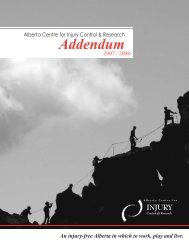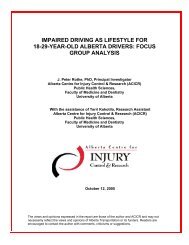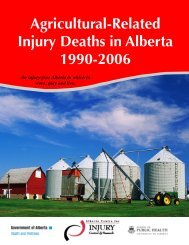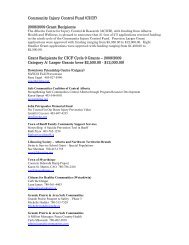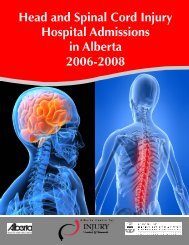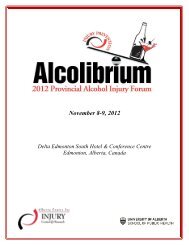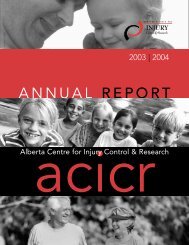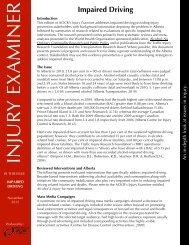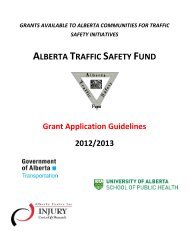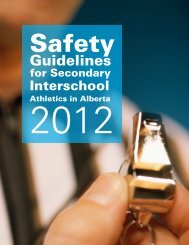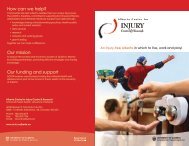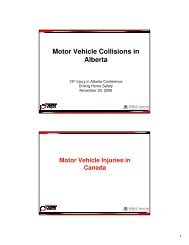ACICR 2007 -2008 Annual Report - Alberta Centre for Injury Control ...
ACICR 2007 -2008 Annual Report - Alberta Centre for Injury Control ...
ACICR 2007 -2008 Annual Report - Alberta Centre for Injury Control ...
Create successful ePaper yourself
Turn your PDF publications into a flip-book with our unique Google optimized e-Paper software.
<strong>Alberta</strong> <strong>Centre</strong> <strong>for</strong> <strong>Injury</strong> <strong>Control</strong> & Research<br />
<strong>Annual</strong> <strong>Report</strong><br />
<strong>2007</strong> / <strong>2008</strong><br />
An injury-free <strong>Alberta</strong> in which to work, play and live.
Table of Contents<br />
‹<br />
‹<br />
‹<br />
‹<br />
‹<br />
‹<br />
‹<br />
‹<br />
‹<br />
‹<br />
‹<br />
‹<br />
‹<br />
‹<br />
‹<br />
‹<br />
‹<br />
‹<br />
4<br />
5<br />
7<br />
8<br />
9<br />
11<br />
14<br />
17<br />
20<br />
23<br />
25<br />
27<br />
28<br />
30<br />
31<br />
32<br />
33<br />
34<br />
Message from the Director & Associate Director<br />
Executive Summary<br />
Vision, Mission, Commitment and Scope / Guiding Principles<br />
Setting Priorities and Identifying Populations / Data<br />
Goals, Strategies and Key Per<strong>for</strong>mance Measures<br />
Goal 1 - Increase the availability and distribution of current high quality data on injury.<br />
Goal 2 - Increase the capacity of injury prevention practitioners to put knowledge into<br />
action (practice and policy) to address the injury issues in their communities.<br />
Goal 3 - Identify, examine and strategically respond to injury issues at all levels.<br />
Goal 4 - Increase access to promising and best practices through evaluation, research<br />
and knowledge translation activities.<br />
Goal 5 - Increase the profile of the injury issue, causes and solutions through focused<br />
advocacy ef<strong>for</strong>ts.<br />
<strong>ACICR</strong> Publications<br />
Community <strong>Injury</strong> <strong>Control</strong> Fund (CICF) Grant Recipients<br />
<strong>Alberta</strong> Traffic Safety Fund (ATSF) Grant Recipients<br />
<strong>ACICR</strong> Committee Representation<br />
Safe Communities<br />
<strong>ACICR</strong> Staff<br />
<strong>ACICR</strong> Associates and <strong>Alberta</strong> Traffic Safety Regional Coordinators<br />
Staff Awards / Acknowledgements and Graduate Students<br />
Financial Statement<br />
<strong>ACICR</strong> <strong>Annual</strong> <strong>Report</strong> <strong>2007</strong> / <strong>2008</strong><br />
‹<br />
3
Message from the Director & Associate Director<br />
We are pleased to present to you the annual report <strong>for</strong> the <strong>Alberta</strong> <strong>Centre</strong> <strong>for</strong> <strong>Injury</strong> <strong>Control</strong> & Research <strong>2007</strong>-<br />
<strong>2008</strong> fiscal year. Last year seemed to bring a bit of everything, from new staff to exciting new initiatives.<br />
Among our activities have been the implementation of the Community Mobilization project of the <strong>Alberta</strong><br />
Traffic Safety Plan and the movement towards a falls prevention strategy <strong>for</strong> older adults. The <strong>Centre</strong> has been<br />
working hard with stakeholders and the Office of Traffic Safety to hire 16 Regional Traffic Safety Coordinators<br />
and to secure host agency agreements. Following our On Solid Ground Conference on fall prevention, interest<br />
in area of fall prevention has taken on a life of its own. The Falls Network has over 89 members that are<br />
dedicated to addressing the issue. Response and excitement about the Canadian Falls Prevention Curriculum<br />
and the public awareness campaign has been overwhelming and speaks to the need felt by stakeholders.<br />
We are happy to report that the <strong>Alberta</strong> <strong>Centre</strong> <strong>for</strong> <strong>Injury</strong> <strong>Control</strong> & Research has begun work to coordinate<br />
development of implementation and evaluation plans <strong>for</strong> the <strong>Alberta</strong> <strong>Injury</strong> <strong>Control</strong> Strategy under the direction<br />
and guidance of a new cross-ministerial steering committee.<br />
<strong>ACICR</strong> as one of the major units within the School of Public Health is also well placed to advance knowledge<br />
translation and research in injury control and has increased our capacity to do so by introducing the <strong>Injury</strong><br />
Examiner series and by developing our injury data brochures. <strong>ACICR</strong>'s core activities of putting knowledge<br />
into action, sharing knowledge to drive change, and identifying and sustaining effective initiatives in policy and<br />
practice will only be enhanced by a stronger research agenda.<br />
Partnership, collaboration, capacity building and evidence-based practice are the pillars on which <strong>ACICR</strong>'s<br />
commitment to injury control is built. We strongly believe that these strategies will build a strong injury control<br />
community in <strong>Alberta</strong>.<br />
An annual report would not be complete without some well deserved “thank-you's”. Firstly, we would like to<br />
take this opportunity to thank the staff of <strong>ACICR</strong> who more often than not, go that extra mile <strong>for</strong> the <strong>Centre</strong>, our<br />
stakeholders and partners. Secondly, thank you to our partners across <strong>Alberta</strong> without your commitment and<br />
perseverance, movement towards an injury-free <strong>Alberta</strong> would be impossible. Finally, we'd like to acknowledge<br />
and thank the <strong>Alberta</strong> Health and Wellness <strong>for</strong> their unwavering commitment to injury control and the <strong>Centre</strong>.<br />
There is still much work to do in injury control but we are confident that if we work together we can create an<br />
injury-free <strong>Alberta</strong>.<br />
D. C. Voaklander, PhD Kathy L Belton, M.Ed<br />
Director<br />
‹<br />
4<br />
<strong>ACICR</strong> <strong>Annual</strong> <strong>Report</strong> <strong>2007</strong> / <strong>2008</strong>
"Individual commitment to a group<br />
ef<strong>for</strong>t - that is what makes a team<br />
work, a company work, a society<br />
work, a civilization work.”<br />
~ Vince Lombardi<br />
Since 1998, the <strong>Alberta</strong> <strong>Centre</strong> <strong>for</strong> <strong>Injury</strong><br />
<strong>Control</strong> & Research (<strong>ACICR</strong>) has taken<br />
many steps towards its vision: an injuryfree<br />
<strong>Alberta</strong> in which to work, play and live.<br />
Each step towards the summit could not<br />
have been achieved without teamwork.<br />
Throughout <strong>2007</strong>/<strong>2008</strong>, teamwork<br />
continued to play an essential role in<br />
<strong>ACICR</strong>'s many achievements. The<br />
importance of teamwork was echoed in the<br />
vision of <strong>ACICR</strong>'s new director, Dr. Don<br />
Voaklander where he identified partnership<br />
as an essential element <strong>for</strong> the development<br />
of relevant, world-class injury control<br />
research and the application of research<br />
creating effective, sustainable initiatives in<br />
policy and community practice.<br />
<strong>ACICR</strong> has established itself as a strong<br />
team member of the University of <strong>Alberta</strong>'s<br />
newest faculty, the School of Public Health,<br />
Canada's first stand alone faculty solely<br />
dedicated to public health. <strong>ACICR</strong>'s team<br />
of researchers and students have focused on<br />
a wide variety of injury issues including the<br />
sociology of injury, traffic safety and<br />
impaired driving, injury in farmers,<br />
psychology and psycho-sociology of injury<br />
recovery, hip fractures and long range<br />
consequences of hospital-related adverse<br />
Executive Summary<br />
events, urban and rural child restraint use<br />
<strong>for</strong> <strong>Alberta</strong> children under the age of 13<br />
years, bicycle helmet use and head injury<br />
be<strong>for</strong>e and after helmet legislation, as well<br />
as injury recovery and the workplace.<br />
<strong>ACICR</strong> has been supporting the cultivation<br />
of future public health leaders with its<br />
highest number of masters and doctoratelevel<br />
practicums and placements to date.<br />
<strong>ACICR</strong> coordinates the <strong>Alberta</strong> <strong>Injury</strong><br />
<strong>Control</strong> Alliance which is a team of 165<br />
members from business and industry,<br />
schools, and community organizations<br />
committed to actualizing the <strong>Alberta</strong> <strong>Injury</strong><br />
<strong>Control</strong> Strategy. The energy of this group<br />
has led to the recent establishment of a<br />
provincial cross-ministerial committee<br />
which will provide guidance and leadership<br />
<strong>for</strong> the implementation of the <strong>Alberta</strong> <strong>Injury</strong><br />
<strong>Control</strong> Strategy. Having this broad, high<br />
level cross-ministerial committee from all<br />
stakeholder perspectives will further ensure<br />
the implementation of the Strategy.<br />
<strong>ACICR</strong>, <strong>Alberta</strong> Medical Association,<br />
<strong>Alberta</strong> Seniors' Falls Prevention Network,<br />
and <strong>Alberta</strong> Seniors' Falls Prevention<br />
Awareness Advisory Committee are<br />
working to create an annual provincial<br />
campaign to generate mass awareness of the<br />
very serious and costly issue of injuries<br />
caused by falls among seniors. The first<br />
campaign will focus on individual and<br />
community action to promote and facilitate<br />
falls prevention. Individual team members<br />
providing input towards this endeavour<br />
consist of health and wellness professionals<br />
from many disciplines including physicians,<br />
physical and occupational therapists,<br />
fitness/recreation professionals, politicians,<br />
researchers, nurses, pharmacists, mental<br />
health specialists, and paramedics. Having<br />
this array of players at the table is sure to<br />
make the first annual campaign a success<br />
setting a solid foundation <strong>for</strong> successive<br />
campaigns.<br />
Community-based collaboration has been<br />
identified as a critical element in achieving<br />
steps towards the accomplishment of goals<br />
conveyed in <strong>Alberta</strong>'s Traffic Safety Plan.<br />
With funding from <strong>Alberta</strong> Health and<br />
Wellness and <strong>Alberta</strong> Transportation,<br />
<strong>ACICR</strong> is facilitating the Community<br />
Mobilization Project to address the plague<br />
of motor vehicle-related deaths and injuries<br />
on <strong>Alberta</strong>'s roadways. Sixteen regional<br />
traffic safety coordinators across the<br />
province will actively engage stakeholders<br />
in their respective communities, working as<br />
a team to identify local traffic safety issues<br />
and make links with provincial initiatives.<br />
From there, teams will develop and<br />
implement programs and awareness<br />
activities reflecting both local traffic issues<br />
and provincial goals. Examples of team<br />
members includes representatives from city,<br />
municipal district, and band councils, law<br />
en<strong>for</strong>cement, <strong>Alberta</strong> Motor Association,<br />
fire and emergency medical services,<br />
family resource centres, Mothers Against<br />
<strong>ACICR</strong> <strong>Annual</strong> <strong>Report</strong> <strong>2007</strong> / <strong>2008</strong> 5<br />
‹
Executive Summary<br />
Drunk Driving, highway maintenance,<br />
school transportation services, health<br />
regions, Commercial Vehicles En<strong>for</strong>cement<br />
Branch, crime prevention committees,<br />
Safety Cit ies, Canadian Society of Safety<br />
Engineering and P.A.R.T.Y. Program s.<br />
With guidance from a multi-sectoral<br />
steering committee, <strong>ACICR</strong> updated and<br />
re<strong>for</strong>matted guidelines featured in the<br />
Safety Guidelines <strong>for</strong> Physical Activity in<br />
<strong>Alberta</strong> Schools. The changes reflected<br />
outputs from the document's evaluation<br />
which was conducted last year. The<br />
evidence-based guidelines presented in the<br />
document provide direction <strong>for</strong> school<br />
boards to establish safety policies <strong>for</strong><br />
curriculum-based physical activities. The<br />
strength of this document is a reflection of the<br />
representatives from a wide variety of<br />
organizations including Edmonton Public and<br />
Catholic Schools, <strong>Alberta</strong> Schools Athletic<br />
Association, <strong>Alberta</strong> Sport, Recreation, Parks<br />
& Wildlife Foundation, <strong>Alberta</strong> Tourism,<br />
Parks, Recreation and Culture, Health and<br />
Physical Education Council, <strong>Alberta</strong> Teachers'<br />
Association, Schools Come Alive, and Sport<br />
Medicine Council of <strong>Alberta</strong>.<br />
<strong>ACICR</strong> invites you to read on and learn more<br />
about accomplishments achieved in the<br />
<strong>2007</strong>/<strong>2008</strong> fiscal year. We are <strong>for</strong>tunate that<br />
there are so many individuals and<br />
organizations in <strong>Alberta</strong> that recognize and<br />
value the importance of injury prevention and<br />
control. It is through team work that <strong>ACICR</strong><br />
has been able to make strides toward an<br />
injury-free <strong>Alberta</strong> in which to work, play and<br />
live.<br />
‹<br />
6<br />
<strong>ACICR</strong> <strong>Annual</strong> <strong>Report</strong> <strong>2007</strong> / <strong>2008</strong>
Vision, Mission, Commitment and Scope<br />
<strong>Alberta</strong> Health and Wellness (AHW), the funder of the <strong>Alberta</strong> <strong>Centre</strong> <strong>for</strong> <strong>Injury</strong> <strong>Control</strong> & Research (<strong>ACICR</strong>)<br />
has a vision of:<br />
Healthy and well <strong>Alberta</strong>ns.<br />
This vision is supported by the vision and mission of the <strong>Alberta</strong><br />
<strong>Centre</strong> <strong>for</strong> <strong>Injury</strong> <strong>Control</strong> & Research (<strong>ACICR</strong>):<br />
The Commitment<br />
<strong>ACICR</strong> is committed to advancing injury control in <strong>Alberta</strong>, by<br />
promoting stakeholder collaboration, capacity building and evidencebased<br />
practice in the field of injury control and research.<br />
The Vision<br />
An injury-free <strong>Alberta</strong> in which to work, play and live.<br />
The Mission<br />
To reduce the societal and economic burden of injuries in <strong>Alberta</strong> by<br />
building partnerships, promoting effective strategies and sharing<br />
knowledge.<br />
The Scope<br />
The <strong>ACICR</strong> will achieve its Vision and Mission by providing<br />
leadership, initiative, influence, coordination and support <strong>for</strong> injuryrelated<br />
policies, education, in<strong>for</strong>mation sharing and research across the<br />
province in order that stakeholders can fulfill their mandates of injury<br />
control.<br />
Guiding Principles<br />
The <strong>ACICR</strong> guiding principles describe our values and lay the<br />
foundation <strong>for</strong> the way in which we approach our work. As a result<br />
these principles influence both our direction and our decisions. We<br />
value and believe in:<br />
• health promotion and five associated action strategies<br />
identified in the Ottawa Chapter (1986):<br />
- Build Healthy Public Policy<br />
- Create Supportive Environments<br />
- Strengthen Community Action<br />
- Develop Personal Skills<br />
- Reorient Health Services<br />
• a population health perspective, where strategies will enhance the<br />
health and well-being of the overall population. We recognize that<br />
different populations and communities will have different issues and<br />
as a result, injury control initiatives will be considered on the basis<br />
of stakeholder support and community readiness<br />
• collaborating with multi-sectoral partners and stakeholders to build<br />
community capacity and develop sustainable injury-related<br />
resources. We respect the contribution and expertise of all parties<br />
involved and support diversity and innovation<br />
• an evidence-based approach and using knowledge translation to<br />
enhance the practice of injury control.<br />
<strong>ACICR</strong> <strong>Annual</strong> <strong>Report</strong> <strong>2007</strong> / <strong>2008</strong> 7<br />
‹
The <strong>ACICR</strong> addresses both intentional<br />
and unintentional injury, and has set<br />
priorities following a review of current<br />
provincial injury surveillance data and<br />
targets. As a result, the following<br />
priority areas have been identified:<br />
• Increasing Awareness of the<br />
<strong>Injury</strong> Issue<br />
• Motor Vehicle Collisions<br />
• Falls<br />
• Suicide<br />
Setting Priorities and Identifying<br />
Populations / Data<br />
Seniors' Falls Data<br />
<strong>Alberta</strong> Seniors' <strong>Injury</strong> Hospital Admissions - 2003<br />
Other Injuries<br />
20%<br />
FFalls<br />
776%<br />
The <strong>ACICR</strong> recognizes the significant<br />
burden of injury within the Aboriginal<br />
population and is committed to<br />
addressing their needs through the<br />
priority areas identified. Although injury<br />
issues affect <strong>Alberta</strong>ns across the<br />
lifespan, <strong>ACICR</strong> has identified other<br />
vulnerable populations that warrant<br />
particular attention including children,<br />
seniors, and the farming community.<br />
<strong>ACICR</strong> also recognizes that<br />
communities are the best suited to<br />
address their own unique injury issues<br />
and is committed to supporting frontline<br />
practitioners and stakeholders to do so.<br />
Motor Vehicle<br />
Collisions<br />
5%<br />
Did You Know in 2003?....<br />
• $88 million was spent on seniors' fall-related hospital admissions. By the year 2033<br />
the seniors population is expected to increase 61% and if left unchecked, the direct<br />
health care costs of fall-related hospital admissions <strong>for</strong> seniors is likely to reach<br />
$250 million every year, a 146% increase.<br />
• These costs do not include emergency department visits, payments to physicians<br />
physiotherapists, homecare, medication or costs to the individual.<br />
• Falls were the leading cause of injury hospital admission <strong>for</strong> seniors with 6,273<br />
admissions.<br />
• Seniors accounted <strong>for</strong> the majority (57%) of all fall-related hospital admissions.<br />
• Falls accounted <strong>for</strong> more than three-quarters (76%) of the seniors admitted to hospital<br />
as the result of an injury.<br />
• There were 17,352 fall-related emergency department visits <strong>for</strong> seniors.<br />
• Fractures accounted <strong>for</strong> 57% of the injuries from a fall.<br />
• Hip fractures were the most common type of fracture.<br />
1 Schopflocher D. On Solid Ground: community conference on seniors' falls prevention. 2006<br />
‹<br />
8<br />
<strong>ACICR</strong> <strong>Annual</strong> <strong>Report</strong> <strong>2007</strong> / <strong>2008</strong>
GOAL 1<br />
Increase the availability and<br />
distribution of current high<br />
quality data on injury.<br />
Core Goals<br />
The <strong>ACICR</strong>, in cooperation with the Health<br />
Surveillance Branch of <strong>Alberta</strong> Health and<br />
Wellness, compiles and analyzes injury<br />
prevalence and incidence data in the province.<br />
Surveillance of the injury issue is important to<br />
evaluate trends over time and to guide<br />
prevention and intervention ef<strong>for</strong>ts. To direct<br />
resources towards injury issues, decision<br />
makers need consistent, comparable data<br />
collected over time. Activities to be<br />
undertaken in this goal area will enhance the<br />
access to current data on injury in a userfriendly<br />
manner.<br />
Key Strategies<br />
1. Improve access to and dissemination of<br />
current injury data <strong>for</strong> stakeholders by<br />
further developing the processes and<br />
structures.<br />
2. Create collaboration partnerships with<br />
sector specific injury data holders such<br />
as transportation or en<strong>for</strong>cement<br />
agencies, targeting identified priorities.<br />
3. Provide input into and advocate <strong>for</strong> the<br />
development of a provincial and national<br />
injury surveillance system.<br />
Key Per<strong>for</strong>mance Measures<br />
• From April 1, <strong>2007</strong> to March 31, <strong>2008</strong><br />
data services completed 137 requests.<br />
• Maintained deaths, hospital admissions<br />
and emergency department data up to<br />
2003.<br />
• 100% of stakeholders contacted indicated<br />
they were satisfied or very satisfied with<br />
the way their data inquires were handled.<br />
• 95% of stakeholders indicated they were<br />
satisfied or very satisfied with the<br />
in<strong>for</strong>mation they received.<br />
• 89% of the stakeholders contacted<br />
indicated they used data or will be using<br />
data they obtained from <strong>ACICR</strong>.<br />
• Stakeholders commented that the data was<br />
not as current as they would have liked.<br />
• A partnership with the Office of the Chief<br />
Medical Examiner has been reestablished.<br />
• <strong>ACICR</strong> created three new summary<br />
brochures: reporting on all injuries,<br />
injuries to children/youth and injuries to<br />
seniors in <strong>Alberta</strong>. The content and <strong>for</strong>mat<br />
of the summary brochure have been<br />
adapted by three health regions to provide<br />
regional specific injury data.<br />
<strong>ACICR</strong> <strong>Annual</strong> <strong>Report</strong> <strong>2007</strong> / <strong>2008</strong> 9<br />
‹
Specialized Data <strong>Report</strong>s<br />
Background<br />
<strong>Injury</strong> prevention requires knowledge of the<br />
frequency and nature of injury incidents.<br />
<strong>ACICR</strong> supports community/regionally-based<br />
decision making in the development,<br />
implementation and evaluation of injury<br />
prevention programs.<br />
Goal<br />
To provide timely and current regional or<br />
topic specific injury data to injury prevention<br />
professionals.<br />
Project Highlights<br />
Status<br />
Ongoing.<br />
Seniors<br />
Injuries in <strong>Alberta</strong><br />
‹<br />
10<br />
<strong>ACICR</strong> <strong>Annual</strong> <strong>Report</strong> <strong>2007</strong> / <strong>2008</strong>
GOAL 2<br />
Core Goals<br />
Increase the capacity of injury<br />
prevention practitioners to put<br />
knowledge into action (practice<br />
and policy) to address the injury<br />
issues in their communities.<br />
In order to effectively address injuries,<br />
practitioners need access to tools, resources<br />
and in<strong>for</strong>mation. <strong>ACICR</strong> will deliver high<br />
quality distinctive educational opportunities,<br />
be a source of expert in<strong>for</strong>mation and<br />
resources, and build social capital between<br />
practitioners through outreach and<br />
engagement.<br />
Key Strategies<br />
1. Maintain a current collection of relevant<br />
injury prevention and control resources<br />
to support practitioners, students and<br />
researchers.<br />
2. Develop and maintain a network of<br />
experts and practitioners that can offer<br />
advice and assistance.<br />
3. Monitor requests <strong>for</strong> in<strong>for</strong>mation<br />
received and the distribution and<br />
dissemination of injury prevention and<br />
control in<strong>for</strong>mation.<br />
4. Broaden the reach, impact and utilization<br />
of current networking and in<strong>for</strong>mation<br />
services.<br />
5. Identify, develop, and deliver injury<br />
prevention related workshops, seminars,<br />
and tools to meet the needs of injury<br />
prevention practitioners.<br />
Key Per<strong>for</strong>mance Measures<br />
• There were 421 new resources added to<br />
the <strong>ACICR</strong> resource room. The online<br />
library website page recorded 567 hits. 43<br />
resources were lent out through the online<br />
process.<br />
• <strong>ACICR</strong> was mentioned in the media a<br />
total of 20 times in <strong>2007</strong>/<strong>2008</strong>.<br />
• In<strong>for</strong>mation was <strong>for</strong>mally distributed 66<br />
times to the RHA and Community<br />
Coalition Safety Promotion Network from<br />
April 1, <strong>2007</strong> to March 31, <strong>2008</strong>.<br />
• <strong>ACICR</strong> responded to 260 requests <strong>for</strong><br />
in<strong>for</strong>mation from April 1, <strong>2007</strong> to<br />
March 31, <strong>2008</strong>.<br />
• 10 monthly teleconferences were held in<br />
<strong>2007</strong>/<strong>2008</strong>, with an average of 40 - 60<br />
participants per session.<br />
• 90% of the respondents of a random<br />
telephone / email survey rated the<br />
monthly teleconference as good to<br />
excellent.<br />
• 100 members on the no-injuries listserv.<br />
• Published 12 issues of the '<strong>Injury</strong> <strong>Control</strong><br />
<strong>Alberta</strong>' newsletter, approximate<br />
distribution: just over 1,250.<br />
• Speaker's registry has 33 speakers<br />
registered.<br />
• <strong>ACICR</strong> staff published 28 journal articles,<br />
and 1 book chapter.<br />
• From April 1, <strong>2007</strong> to March 31, <strong>2008</strong><br />
there were 9,053 visitors to the <strong>ACICR</strong><br />
website.<br />
• Maintained and updated the <strong>ACICR</strong><br />
database of multidisciplinary researchers,<br />
educators, and practitioners, current<br />
numbers of records 6,326.<br />
• 100% of stakeholders rated <strong>ACICR</strong><br />
workshops, seminars, and tools as good or<br />
excellent.<br />
<strong>ACICR</strong> <strong>Annual</strong> <strong>Report</strong> <strong>2007</strong> / <strong>2008</strong> 11<br />
‹
<strong>ACICR</strong> Library<br />
Project Highlights<br />
Background<br />
The <strong>ACICR</strong> Library is a key component of<br />
<strong>ACICR</strong>'s commitment to sharing in<strong>for</strong>mation<br />
with stakeholders. Materials include books,<br />
grey literature, videos, reports, pamphlets,<br />
CD-ROMs and various other items that<br />
provide in<strong>for</strong>mation on injury control topics<br />
including intervention techniques such as<br />
social marketing, advocacy and community<br />
collaboration. In total, the Library houses over<br />
2,200 items. Holdings can be accessed in<br />
person and online via a searchable database<br />
linked to the <strong>ACICR</strong> website.<br />
Status<br />
The online library database was fully<br />
implemented in 2005/2006. This database has<br />
enhanced search capability and features a<br />
reservation request service <strong>for</strong> borrowing<br />
materials. Over the year the online library<br />
website recorded 567 hits. Forty-three<br />
resources were lent out through the online<br />
process and four hundred and twenty-one new<br />
materials were acquired this year.<br />
Goal<br />
To maintain and develop a collection of injury<br />
prevention and control literature, projects and<br />
in<strong>for</strong>mation <strong>for</strong> access by stakeholders.<br />
Objectives<br />
1. Capture all materials in a searchable<br />
database.<br />
2. Make the resources housed in the Library<br />
accessible to injury prevention and<br />
control stakeholders, students and other<br />
interested individuals.<br />
‹<br />
12<br />
<strong>ACICR</strong> <strong>Annual</strong> <strong>Report</strong> <strong>2007</strong> / <strong>2008</strong>
Project Highlights<br />
<strong>Alberta</strong> <strong>Injury</strong> <strong>Control</strong> Teleconference<br />
Background<br />
The <strong>Alberta</strong> <strong>Injury</strong> <strong>Control</strong> Teleconference<br />
arose out of a need identified by the<br />
participants of the <strong>Injury</strong> in <strong>Alberta</strong> V<br />
Conference to network and share in<strong>for</strong>mation<br />
among stakeholders in the field of injury<br />
prevention and control across the province.<br />
There is an average of 30 ports per session<br />
with anywhere from 40-60 participants.<br />
Results from a monthly random telephone<br />
survey indicated that the teleconference is a<br />
useful resource <strong>for</strong> injury prevention and<br />
control practitioners across the province and<br />
Canada wide.<br />
3. Act as a <strong>for</strong>um <strong>for</strong> educational<br />
opportunities, in<strong>for</strong>mation sharing and<br />
discussion <strong>for</strong> stakeholders.<br />
Status<br />
<strong>2007</strong>/<strong>2008</strong> teleconference series is underway.<br />
A random telephone survey is conducted<br />
following each monthly teleconference and 9<br />
out of 10 respondents rated the <strong>ACICR</strong><br />
teleconference series as good or excellent.<br />
Goal<br />
To develop and maintain an in<strong>for</strong>mation<br />
sharing network <strong>for</strong> injury control<br />
practitioners across the province and Canada.<br />
Objectives<br />
1. Provide leadership and coordination<br />
in building and maintaining in<strong>for</strong>mation<br />
networks among injury control<br />
stakeholders and practitioners while<br />
ensuring consistent in<strong>for</strong>mation and<br />
effective dissemination of injury control<br />
in<strong>for</strong>mation and resources.<br />
2. Provide a mechanism <strong>for</strong> timely<br />
in<strong>for</strong>mation sharing and <strong>for</strong>um <strong>for</strong><br />
discussing issues of interest to injury<br />
prevention practitioners across Canada.<br />
<strong>ACICR</strong> <strong>Annual</strong> <strong>Report</strong> <strong>2007</strong> / <strong>2008</strong> 13<br />
‹
GOAL 3<br />
Identify, examine and<br />
strategically respond to injury<br />
issues at all levels.<br />
Core Goals<br />
The identification and monitoring of new and<br />
emerging injury issues is a fundamental first<br />
step to a strategic response. Examination of<br />
the underlying causes of injury is also key to<br />
effectively addressing injury issues. <strong>ACICR</strong><br />
will develop a proactive plan to address injury<br />
issues as they emerge through a three-prong<br />
approach of knowledge gathering and review,<br />
synthesis and communication. Where,<br />
appropriate <strong>ACICR</strong> will provide supportive<br />
coordination to enhance the integration of<br />
ef<strong>for</strong>ts towards injury issues.<br />
Key Strategies<br />
1. Collaborate with RHAs, provincial<br />
agencies, organizations and government<br />
departments to create and support<br />
effective processes and structures <strong>for</strong><br />
injury prevention and control.<br />
2. Engage communities of interest <strong>for</strong><br />
priority provincial injury prevention<br />
initiatives.<br />
3. Provide the appropriate level of<br />
leadership and support needed to develop<br />
and implement injury prevention<br />
initiatives within injury prevention<br />
communities of interest.<br />
4. Coordinate the <strong>Alberta</strong> <strong>Injury</strong> <strong>Control</strong><br />
Alliance and advocate <strong>for</strong> the adoption<br />
and implementation of the <strong>Alberta</strong> <strong>Injury</strong><br />
<strong>Control</strong> Strategy.<br />
Key Per<strong>for</strong>mance Measures<br />
• During <strong>2007</strong>/<strong>2008</strong>, the membership of the<br />
<strong>Alberta</strong> <strong>Injury</strong> <strong>Control</strong> Alliance grew<br />
to 165.<br />
• Community <strong>Injury</strong> <strong>Control</strong> Fund (CICF)<br />
awarded 7 larger grants and 15 smaller<br />
grants totalling $101,820.<br />
• 76 programs and projects were<br />
maintained or supported by <strong>ACICR</strong>.<br />
• 34 new initiatives, programs and<br />
projects being implemented by<br />
stakeholders in partnership with <strong>ACICR</strong>.<br />
• Distributed 2 news releases between<br />
April 1, <strong>2007</strong> and March 31, <strong>2008</strong>.<br />
• 6 communities of interest were <strong>for</strong>med.<br />
‹<br />
14<br />
<strong>ACICR</strong> <strong>Annual</strong> <strong>Report</strong> <strong>2007</strong> / <strong>2008</strong>
Project Highlights<br />
<strong>Alberta</strong> Seniors' Falls Prevention Network<br />
Background<br />
Based on the feedback from the September<br />
2006 On Solid Ground Community<br />
Conference on falls prevention, an electronic<br />
network has been established to link people<br />
working in the area of seniors' falls prevention<br />
throughout the province. This network allows<br />
members to share in<strong>for</strong>mation such as new<br />
programs and resources, recent research and<br />
upcoming events and conferences. The<br />
network was officially launched in May <strong>2007</strong><br />
and to date has 89 members from a variety of<br />
backgrounds and occupations.<br />
Status<br />
Ongoing.<br />
Partners & Sponsors<br />
Individuals and organizations working<br />
throughout <strong>Alberta</strong> in the area of seniors' falls<br />
prevention in the community, acute care,<br />
continuing care, rehabilitation, injury<br />
prevention, health promotion and fitness<br />
settings.<br />
Goal<br />
To provide members working in the area of<br />
seniors' falls prevention with an opportunity<br />
<strong>for</strong> networking, collaboration, in<strong>for</strong>mation<br />
sharing and education.<br />
Objectives<br />
1. Maintain Network contact list and<br />
disseminate in<strong>for</strong>mation on seniors' falls<br />
prevention, programming, education,<br />
workshops, etc. via electronic<br />
distribution list.<br />
2. Coordinate teleconference/internet<br />
meetings.<br />
3. Develop a dedicated webpage <strong>for</strong><br />
seniors' falls prevention on <strong>ACICR</strong>'s<br />
website containing in<strong>for</strong>mation on best<br />
practices, programs, resources etc.<br />
<strong>ACICR</strong> <strong>Annual</strong> <strong>Report</strong> <strong>2007</strong> / <strong>2008</strong> 15<br />
‹
Project Highlights<br />
<strong>Alberta</strong> Traffic Safety Plan - Community Mobilization Project<br />
Background<br />
On November 2, 2006, the <strong>Alberta</strong><br />
government released <strong>Alberta</strong>'s Traffic Safety<br />
Plan: Saving Lives on <strong>Alberta</strong>'s Roads. The<br />
plan is a comprehensive strategy designed to<br />
reduce the number of motor vehicle-related<br />
deaths and injuries occurring on <strong>Alberta</strong>'s<br />
roadways. The plan identifies numerous<br />
initiatives in key areas including: leadership<br />
and communication, community traffic safety,<br />
public education and awareness, research and<br />
evidence-based decisions, sustained<br />
en<strong>for</strong>cement, legislation based on best<br />
practices and engineering and infrastructure<br />
improvements.<br />
The government recognizes that in order to<br />
achieve the goals defined in the <strong>Alberta</strong><br />
Traffic Safety Plan coordinated, collaborative<br />
community based delivery of<br />
programs/initiatives/communications will be<br />
critical. To facilitate the community focus,<br />
funding has been provided by <strong>Alberta</strong> Health<br />
and Wellness and <strong>Alberta</strong> Transportation <strong>for</strong><br />
16 FTE regional traffic safety coordinators to<br />
be located across the province. Eleven of the<br />
coordinators will be located in areas defined<br />
by the Regional Health Authority boundaries.<br />
Aspen RHA and Northern Lights RHA will<br />
each have 2 FTE coordinators due to the large<br />
geographic area covered by these RHAs. Five<br />
traffic safety coordinators will be located in<br />
Aboriginal communities (1 in each Treaty<br />
Region and 2 to represent Métis<br />
communities).<br />
The regional traffic safety coordinators will be<br />
hired on contract by the <strong>Alberta</strong> <strong>Centre</strong> <strong>for</strong><br />
<strong>Injury</strong> <strong>Control</strong> & Research to facilitate the<br />
development of traffic safety committees, to<br />
assist with identification of local traffic safety<br />
issues and to link with provincial initiatives.<br />
These positions will be expected to build on<br />
existing partnerships and committees and to<br />
act as a traffic safety resource to local<br />
communities.<br />
Objectives<br />
1. To collaborate with <strong>Alberta</strong> Health and<br />
Wellness and <strong>Alberta</strong> Transportation in<br />
the design of the community<br />
mobilization model and the development<br />
of the Community Traffic Safety<br />
Coordinator positions.<br />
2. To assist in identifying communities of<br />
interest <strong>for</strong> traffic safety in each health<br />
region and Aboriginal area.<br />
3. To work with communities of interest to<br />
identify a host agency <strong>for</strong> the regional<br />
traffic safety coordinator and to select an<br />
appropriate candidate <strong>for</strong> the position.<br />
4. To enter into annual contract agreements<br />
with individuals identified by regional<br />
coalitions as their choices <strong>for</strong> regional<br />
traffic safety coordinators.<br />
5. To work with the Provincial Office of<br />
Traffic Safety to ensure regional traffic<br />
safety coordinator positions and plans are<br />
aligned with the <strong>Alberta</strong> Traffic Safety<br />
Plan.<br />
Status<br />
1. Host agencies located <strong>for</strong> 16 of the<br />
regional traffic safety coordinator<br />
positions.<br />
2. Ten regional traffic safety coordinators<br />
hired.<br />
3. Recruitment process <strong>for</strong> the regional<br />
traffic safety coordinators underway <strong>for</strong><br />
6 positions.<br />
4. RTSC positions recently re-evaluated to<br />
a higher pay grade.<br />
Partners & Sponsors<br />
• <strong>Alberta</strong> Health and Wellness<br />
• <strong>Alberta</strong> Sheriffs<br />
• <strong>Alberta</strong> Transportation<br />
• Aspen Health Region<br />
• Calgary Health Region<br />
• Canadian Traffic Safety Institute<br />
• Central Agencies Inc.<br />
• David Thompson Health Region<br />
• En<strong>for</strong>cement Agencies<br />
• First Nations Treaty 6<br />
• First Nations Treaty 7<br />
• First Nations Treaty 8<br />
• Mackenzie County<br />
• Métis General Settlement Council<br />
• Métis Nation of <strong>Alberta</strong><br />
• Other community traffic safety<br />
stakeholders<br />
• RCMP<br />
• South Eastern <strong>Alberta</strong> Safety Alliance<br />
Society<br />
• St. John Ambulance (Lethbridge Office)<br />
• Strathcona County<br />
• TASC Enterprises<br />
‹<br />
16<br />
<strong>ACICR</strong> <strong>Annual</strong> <strong>Report</strong> <strong>2007</strong> / <strong>2008</strong>
GOAL 4<br />
Core Goals<br />
Increase access to promising and<br />
best practices through<br />
evaluation, research and<br />
knowledge translation activities.<br />
Access to current and promising in<strong>for</strong>mation<br />
regarding interventions and practices ensures<br />
that resources are being used to address injury<br />
issues in the most effective ways possible.<br />
<strong>ACICR</strong> will bring together study teams of<br />
experts, academics and practitioners to seek<br />
knowledge about injury issues and to<br />
determine, implement and or evaluate<br />
innovative solutions to injury issues. The<br />
<strong>ACICR</strong> will also encourage collaborative<br />
interdisciplinary research ef<strong>for</strong>ts that are<br />
reflective of the injury issues in <strong>Alberta</strong> with<br />
an emphasis on the transfer of research<br />
knowledge into practice.<br />
Key Strategies<br />
1. Provide program evaluation support to<br />
community-based injury prevention<br />
programs/ projects/ initiatives.<br />
2. Provide support to develop research<br />
capacity at the community level.<br />
3. Conduct research on priority injury<br />
issues in <strong>Alberta</strong>.<br />
4. Provide evidence on the best and<br />
promising practices in injury prevention<br />
in a user-friendly manner.<br />
Key Per<strong>for</strong>mance Measures<br />
• Three evaluations were undertaken on<br />
community-based injury prevention<br />
programs/projects/initiatives.<br />
• 14 applied research projects were<br />
undertaken to study the determinants of<br />
specific injuries as identified by<br />
stakeholders and practitioners.<br />
• Three consultations on evaluation and<br />
research were provided to injury<br />
stakeholders in <strong>Alberta</strong>.<br />
• 56 presentations were made at local<br />
provincial conferences and symposiums<br />
to support programs.<br />
• 28 articles were published in scientific<br />
journals and local organization<br />
newsletters.<br />
• Supported delivery of CIPC training<br />
sessions: one in British Columbia, one in<br />
<strong>Alberta</strong>, three in Ontario, one in Quebec<br />
and two in Nova Scotia.<br />
• Supported the delivery of two CIPC<br />
facilitator training sessions: one in<br />
Ontario and one in British Columbia.<br />
• <strong>ACICR</strong> facilitated 9 educational<br />
opportunities.<br />
<strong>ACICR</strong> <strong>Annual</strong> <strong>Report</strong> <strong>2007</strong> / <strong>2008</strong> 17<br />
‹
Project Highlights<br />
Canadian Falls Prevention Curriculum (CFPC)<br />
Background<br />
For seniors, the risk of falling and sustaining<br />
an injury is influenced by a broad set of health<br />
determinants, including physical, behavioural,<br />
environmental, social and economic factors.<br />
Interest and activity in the area of preventing<br />
falls among older adults has increased<br />
exponentially in recent years. Studies have<br />
identified falls among seniors as the most<br />
costly injuries. With the aging of the baby<br />
boomers, the prevention of falls and related<br />
injuries among older adults is becoming an<br />
even more critical health issue.<br />
Much work has been done in identifying what<br />
works in preventing falls in the older<br />
population and many initiatives are being<br />
implemented across the country. However,<br />
many of those tasked with developing and<br />
implementing these initiatives have not had<br />
previous experience in the field of injury<br />
prevention in general, nor specific training in<br />
falls prevention among older adults.<br />
The Canadian Falls Prevention Curriculum©<br />
(CFPC) will build on the CIPC (Canadian<br />
<strong>Injury</strong> Prevention Curriculum) but create new<br />
content specific to falls prevention among<br />
older adults, with greater focus on the<br />
interrelationship of the determinants of health<br />
that affect falls. The new two-day course will<br />
provide participants with an understanding of<br />
how to operate from a evidence-based<br />
approach to seniors' falls prevention.<br />
Goal<br />
To enhance the capacity of Canadian health<br />
care and community practitioners to plan,<br />
implement and evaluate evidence- based falls<br />
prevention programs that will empower<br />
seniors to minimize their risk of falling.<br />
Objectives<br />
Write draft and final versions of the CFPC in<br />
English and French that will give practitioners<br />
working in the area of seniors' falls prevention<br />
the skills necessary to operate from an<br />
evidence-based approach to seniors' falls<br />
prevention.<br />
1. Test the CFPC in three training sessions.<br />
2. Write draft and final version of CFPC<br />
Facilitator Manual.<br />
3. Test the CFPC Facilitator course in<br />
pilot training sessions.<br />
4. Design and implement a communication<br />
and marketing strategy.<br />
Status<br />
Curriculum finalized and now ready <strong>for</strong> wide<br />
spread distribution.<br />
Partners & Sponsors<br />
• British Columbia <strong>Injury</strong> Research and<br />
Prevention Unit<br />
• PEI <strong>Centre</strong> <strong>for</strong> the Study of Health<br />
& Aging, University of Prince Edward<br />
Island<br />
• PEI Seniors' Falls Prevention Coalition<br />
• Public Health Agency of Canada<br />
‹<br />
18<br />
<strong>ACICR</strong> <strong>Annual</strong> <strong>Report</strong> <strong>2007</strong> / <strong>2008</strong>
Graduate Student Research<br />
Program<br />
Project Highlights<br />
Leah Phillips - (PhD) Injured workers at risk of poor recovery.<br />
Who recovers? Who doesn't?<br />
Background<br />
Student Research Program of <strong>ACICR</strong><br />
provides opportunities <strong>for</strong> post-secondary<br />
students to gain an understanding of and<br />
appreciation <strong>for</strong> the emerging field of<br />
injury control.<br />
Goal<br />
The goal of the student research program is<br />
to increase the number of people working<br />
in the field of injury control by providing<br />
experience through research projects.<br />
Status<br />
Ongoing<br />
Background<br />
Seeks to identify potentially modifiable<br />
psychosocial prognostic factors <strong>for</strong> recovery in<br />
a treatment group of injured workers at a<br />
Rehabilitation Center. This work will focus on<br />
pain coping strategies in injured workers.<br />
Recent research has identified pain coping as<br />
one of the strongest prognostic factors in<br />
recovery from neck pain in the general<br />
population, and has also shown to be important<br />
in recovery after a whiplash injury. Yet, there is<br />
scarce research in understanding pain coping in<br />
an occupational cohort.<br />
Goal<br />
The goals of this work are two fold to gain (1)<br />
an understanding of the prognostic role of pain<br />
coping on recovery from a work related injury<br />
(Phase I); and to (2) develop an understanding<br />
of the experience of coping from the workers'<br />
perspectives, e.g., how these individuals cope<br />
with their pain, how they <strong>for</strong>m pain coping<br />
strategies and what reasoning they give <strong>for</strong><br />
using these strategies (Phase II).<br />
Objectives<br />
The primary objective of this work is to<br />
decrease the burden of occupational injury. If<br />
pain coping shows to be a predictive factor <strong>for</strong><br />
recovery in this group of workers, it is a<br />
reasonable target <strong>for</strong> interventions, while the<br />
qualitative work will provide much more<br />
in<strong>for</strong>mation about how to intervene in coping,<br />
and who to intervene with.<br />
A secondary research objective is the<br />
exploration of the efficacy of the treatment<br />
program by examining and comparing three<br />
distinct outcome measures used by the<br />
rehabilitation center.<br />
Status<br />
A full proposal has been drafted. Ethics<br />
documentation <strong>for</strong> this project is currently<br />
being prepared.<br />
Partners & Sponsors<br />
• Dr. Linda Carroll, Dr. Peter Rothe,<br />
Dr. Don Voaklander, Dr. Doug Grosse<br />
(supervisory committee)<br />
• Millard Health Rehabilitation Center,<br />
Edmonton, <strong>Alberta</strong>.<br />
<strong>ACICR</strong> <strong>Annual</strong> <strong>Report</strong> <strong>2007</strong> / <strong>2008</strong> 19<br />
‹
GOAL 5<br />
Core Goals<br />
Increase the profile of the injury<br />
issue, causes and solutions<br />
through focused advocacy<br />
ef<strong>for</strong>ts.<br />
In order to advance the injury issue as a major<br />
public health issue in <strong>Alberta</strong> concerted ef<strong>for</strong>ts<br />
will have to be taken. <strong>ACICR</strong> will build<br />
public awareness and political will to address<br />
the injury issue through awareness raising<br />
activities such as media campaigns and<br />
targeted promotions to influence the<br />
development and implementation of healthy<br />
public policy at all levels from local to<br />
international.<br />
Key Strategies<br />
1. Improve <strong>Alberta</strong>ns' knowledge about the<br />
injury issue through effective<br />
communication and marketing of the<br />
injury issue.<br />
2. Support provincial and national public<br />
policy advocacy ef<strong>for</strong>ts related to the<br />
injury issue.<br />
3. In<strong>for</strong>m public policy makers about the<br />
causes and solutions to the injury issue.<br />
Key Per<strong>for</strong>mance Measures<br />
• Six concentrated advocacy ef<strong>for</strong>ts<br />
were undertaken or supported.<br />
• Developed 3 new position<br />
statements which called <strong>for</strong> legislative<br />
change in the areas of ATVs, baby bath<br />
seats or bath rings and graduated drivers<br />
licensing.<br />
• Researched and wrote a brief<br />
recommending legislation under the<br />
Hazardous Products Act to establish a<br />
prohibition on the advertisement, sale and<br />
importation of bath seats and bath rings<br />
that do no meet the requirements of a<br />
referenced technical standard. The<br />
brief also calls <strong>for</strong> support <strong>for</strong><br />
caregivers in providing adequate<br />
supervision of infants in baths through a<br />
multi-faceted approach.<br />
• Enhanced and disseminated materials<br />
calling <strong>for</strong> improvements to <strong>Alberta</strong>'s<br />
GDL system.<br />
• Broadened our position statement<br />
regarding legislative improvements to<br />
protect ATV users.<br />
‹<br />
20<br />
<strong>ACICR</strong> <strong>Annual</strong> <strong>Report</strong> <strong>2007</strong> / <strong>2008</strong>
Project Highlights<br />
Baby Walkers - Position Statement and Response to Board of Review<br />
Background<br />
Baby walkers are considered to be an<br />
inherently dangerous product, exposing<br />
infants to injury from falls down stairs and<br />
from pulling objects down on themselves that<br />
they would otherwise be unable to reach.<br />
In 1989, representatives of the baby walker<br />
industry in Canada addressed the risk of<br />
injuries known to be associated with baby<br />
walkers by voluntarily adopting a safety<br />
standard <strong>for</strong> baby walkers. Voluntary<br />
adherence to this standard became a de facto<br />
ban and was effective <strong>for</strong> many years in<br />
restricting the sale of baby walkers in Canada.<br />
As time passed, there was increasing evidence<br />
that baby walkers were slowly making their<br />
way back into the Canadian marketplace. As<br />
a result, in 2004 Health Canada instituted a<br />
ban on the importation, sale or advertising of<br />
baby walkers in Canada.<br />
However, the ban was challenged and in<br />
September 2006 Health Canada convened a<br />
Board of Review to inquire into the "nature<br />
and characteristics" of baby walkers, and to<br />
hear representations and evidence from any<br />
person affected by the prohibition.<br />
Goal<br />
To reduce the number of infants injured in<br />
baby walkers by seeing the ban of the<br />
importation, sale or advertising of baby<br />
walkers in Canada upheld.<br />
Objective<br />
To prepare an evidenced-based position<br />
statement and submission to the Board of<br />
Review supporting the ban.<br />
Status<br />
The submission was accepted as evidence by<br />
the Board of Review. In its analysis on nature<br />
and characteristics, the Board of Review<br />
determined that a baby walker is hazardous in<br />
nature, in that its characteristics and their<br />
consequences are imbedded with elements of<br />
risk and danger. The Board of Review has<br />
unanimously agreed that the ban implemented<br />
by the Government of Canada on the<br />
advertising, sale and importation of baby<br />
walkers was justified on the basis of the<br />
available evidence. Our submission is posted<br />
on the <strong>ACICR</strong> website under the Advocacy<br />
tab.<br />
Partners & Sponsors<br />
• Chinook Health Region<br />
• East Central Health Region<br />
• KidSafe Connection, Capital Health<br />
• Northern Lights Health Region<br />
• Safe Kids Canada<br />
<strong>ACICR</strong> <strong>Annual</strong> <strong>Report</strong> <strong>2007</strong> / <strong>2008</strong> 21<br />
‹
Project Highlights<br />
Seeking Improvements to <strong>Alberta</strong>'s Graduated Drivers Licensing (GDL) System<br />
Background<br />
<strong>Alberta</strong> instituted a GDL program in May of<br />
2003. While there has been a reduction in the<br />
number of casualty collisions in drivers aged<br />
16 to 19 years, motor vehicle collisions<br />
continue to be the leading killer of <strong>Alberta</strong>ns<br />
in this age category.<br />
In October 2005, the Traffic <strong>Injury</strong> Research<br />
Foundation (TIRF) published research<br />
findings outlining best practices <strong>for</strong> graduated<br />
driver licensing in Canada. The purpose of<br />
their report was to describe the best practices<br />
which can be used as a standard <strong>for</strong> the<br />
development of new programs in Canada and<br />
<strong>for</strong> the enhancing the effectiveness of those<br />
already in place. Within the document TIRF<br />
highlights five priority areas on which<br />
jurisdictions should focus their GDL<br />
programs.<br />
Goal<br />
To reduce the number of casualty collisions<br />
among new, young drivers by seeking<br />
enhanced effectiveness of <strong>Alberta</strong>'s GDL<br />
program.<br />
Objective<br />
To make injury prevention partners and<br />
policy-makers aware of TIRF's evidencebased<br />
recommendations <strong>for</strong> enhancing<br />
<strong>Alberta</strong>'s GDL program and to seek policy<br />
changes to bring <strong>Alberta</strong>'s GDL program in<br />
line with TIRF's priority<br />
recommendations.<br />
Status<br />
A complete package of materials about<br />
improving GDL, including a Position<br />
Statement, has been written and posted on the<br />
<strong>ACICR</strong> website. The aim of these materials is<br />
to coordinate the message coming from all<br />
injury prevention partners about GDL<br />
improvements. In<strong>for</strong>mation on the issue<br />
continues to be spread via the <strong>ACICR</strong><br />
communication vehicles, through meetings<br />
with potential partners and with policymakers.<br />
A resolution calling <strong>for</strong> improvements<br />
to GDL was adopted by the <strong>Alberta</strong> Public<br />
Health Association at its <strong>2007</strong> AGM.<br />
‹<br />
22<br />
<strong>ACICR</strong> <strong>Annual</strong> <strong>Report</strong> <strong>2007</strong> / <strong>2008</strong>
<strong>ACICR</strong> PUBLICATIONS As of March <strong>2008</strong><br />
Book Chapter<br />
Côté P, Carroll LJ, Cassidy JD, Rezai M, Kristman V, and the Scientific<br />
Secretariat of the Bone and Joint Decade 2000-2010 Task Force on Neck Pain<br />
and its Associated Disorders. A review of the epidemiology of neck pain in<br />
workers: Prevalence, incidence, and risk factors. In Nordin M, Anderson GBJ,<br />
Pope M. (Eds). Musculoskeletal Disorders in the Workplace: Principles and<br />
Practice. Philadelphia, PAL: Mosby Elsevier, <strong>2007</strong>, 25-40.<br />
Peer Reviewed Journal Articles and Abstracts<br />
(Listed in alphabetical order)<br />
Carragee EJ, Hurwitz EL, Cheng I, Carroll LJ, Nordin M, Guzman J, Pelosos<br />
PM, Holm LW, Côté P, Hogg-Johnson S, van der Velde G, Cassidy JD, Haldeman<br />
S. Treatment of neck pain: Injections and surgical Interventions. Results of the<br />
Bone and Joint Disorder Decade 2000-2010 Task Force on Neck Pain and Its<br />
Associated Disorders. Spine <strong>2008</strong>; 33(4S): S153-S169.<br />
Carroll LJ, Cassidy JD, Peloso PM, Giles-Smith L, Cheng CS, Greenhalgh S,<br />
Haldeman S, van der Velde G, Holm LW, Hurwitz EL, Côté P, Nordin M, Hogg-<br />
Johnson S, Holm LW, Guzman J, Carragee EJ. Methods <strong>for</strong> the best evidence<br />
synthesis on neck pain and its associated disorders. The Bone Joint Decade 2000-<br />
2010 Task Force on Neck Pain and Its Associated Disorders. Spine <strong>2008</strong>:33(4S):<br />
S33-S38.<br />
Carroll LJ, Ferrari R, Cassidy JD. Reduced or painful jaw movement after<br />
traffic injuries: A population-based study. Journal of American Dental<br />
Association <strong>2007</strong>; 138:86-93.<br />
Carroll LJ, Hogg-Johnson S, van der Velde G, Haldeman S, Holm LW, Carragee<br />
EJ, Hurwitz EL, Côté P, Nordin M, Peloso PM, Cassidy JD, Guzman J. Course<br />
and prognostic factors <strong>for</strong> neck pain in the general population. Results of the<br />
Bone and Joint 2000-2010 Task Force on Neck Pain and Its Associated<br />
Disorders. Spine <strong>2008</strong>; 33(4S):S75-S82.<br />
Carroll LJ, Holm LW, Hogg-Johnson S, Côté P, Cassidy JD, Haldeman S,<br />
Nordin M, Hurwitz EL, Carragee EJ, van der Velde G, Pelosos PM, Guzman J.<br />
Course and prognostic factor <strong>for</strong> neck pain in whiplash-associated disorders<br />
(WAD). Results of the Bone and Joint Decade 2000-2010 Task Force on Neck<br />
Pain and Its Associated Disorders. Spine <strong>2008</strong>; 33(4S): S83-S92.<br />
Carroll LJ, Hogg-Johnson S, Côté P, van der Velde G, Holm LW, Carragee EJ,<br />
Hurwitz EL, Pelosos PM, Cassidy JD, Guzman J, Nordin M, Haldeman S.<br />
Course and prognostic factors <strong>for</strong> neck pain in workers. Results of the Bone and<br />
Joint Decade 2000-2010 Task Force on Neck Pain and Its Associated Disorders.<br />
Spine <strong>2008</strong>; 33(4S):S93-S100.<br />
Carroll LJ, Hurwitz EL, Côté P, Hogg-JohnsonS, Carragee EJ, Nordin M, Holm<br />
LW, van der Velde G, Cassidy JD, Guzman J, Peloso PM, Haldeman S. Research<br />
priorities and methodological implications. Results of the Bone and Joint Decade<br />
2000-2010 Task Force and Neck Pain and Its Associated Disorders. Spine <strong>2008</strong>;<br />
33(4S):S214-S220.<br />
Côté P, Hogg-Johnson S, Cassidy JD, Carroll LJ, Frank J, Bombardier C. Early<br />
Aggressive Care and Delayed Recovery from Whiplash: Isolated Finding or<br />
Reproducible Result? Arthritis Care and Research <strong>2007</strong>; 57:861-868.<br />
Côté P, van der Velde G, Cassidy JD, Carroll LJ, Hogg-Johnson S, Holm LW,<br />
Carragee EJ, Haldeman S, Nordin M, Hurwitz EL, Guzman J, Peloso PM. The<br />
Burden and determinants of neck pain in workers. Results of the Bone and Joint<br />
2000-2010 Task Force on Neck Pain and Its Associated Disorders. Spine <strong>2008</strong>;<br />
33(4S):S60-S74.<br />
Day L, Langley J, Stathakis V, Wolfe R, Sim M, Voaklander DC, Ozanne-Smith<br />
J. Challenges of recruiting farm injury study participants through hospital<br />
emergency departments. <strong>Injury</strong> Prevention <strong>2007</strong>; 13: 88-92.<br />
Guzman J, Haldeman S, Carroll LJ, Carragee EJ, Hurwitz EL, Peloso PM,<br />
Nordin M, Cassidy JD, Holm LW, Côté P, van der Velde G, Hogg-Johnson S.<br />
Practice implications of the results of the Bone and Joint Decade 2000-2010 Task<br />
Force on Neck Pain and Its Associated Disorders: From concepts and findings to<br />
recommendations. Spine <strong>2008</strong>; 33(4S):S199-S213.<br />
Guzman J, Hurwitz EL, Carroll LJ, Haldeman S, Côté P, Carragee EJ, Peloso<br />
PM, van der Velde G, Holm LW, Hogg-Johnson S, Nordin M, Cassidy JD. A<br />
Conceptual model <strong>for</strong> the course and care of neck pain. Results of the Bone and<br />
Joint Decade 2000-2010 Task Force on Neck Pain and Its Associated Disorders.<br />
Spine <strong>2008</strong>; 33(4S): S14-S23.<br />
Hagel BE, Rizkallah JW, Lamy A, Belton KL, Jhangri GS, Cherry N, Rowe, BH.<br />
The prevalence and reliability of visibility aid and other risk factor data <strong>for</strong><br />
uninjured cyclists and pedestrians in Edmonton, <strong>Alberta</strong>, Canada. Accident<br />
Analysis and Prevention <strong>2007</strong>:39, 284-289.<br />
Haldeman S, Carroll LJ, Cassidy JD. A Best Evidence Synthesis on Neck Pain:<br />
Findings from the Bone and Joint Decade 2000-2010 Task Force in Neck Pain<br />
and Its Associated Disorders. Spine <strong>2008</strong>; 33(4S). (Citation <strong>for</strong> complete report)<br />
Haldeman S, Carroll LJ, Cassidy JD, Schubert J, Nygren A. Executive<br />
summary: The Bone and Joint Decade 2000-2010 Task Force on Neck Pain and<br />
Its Associated Disorders. Spine <strong>2008</strong>; 33(4S): S5-S7.<br />
<strong>ACICR</strong> <strong>Annual</strong> <strong>Report</strong> <strong>2007</strong> / <strong>2008</strong> 23<br />
‹
<strong>ACICR</strong> PUBLICATIONS As of March <strong>2008</strong><br />
Haldeman S, Carroll LJ, Cassidy JD. Introduction/Mandate: The empowerment<br />
of people with neck pain. The Bone and Joint Decade 2000-2010 Task Force on<br />
Neck Pain and Its Associated Disorders. Spine <strong>2008</strong>; 33(4S):S8-S13.<br />
Hogg-Johnson S, van der Velde G, Carroll LJ, Holm LW, Cassidy JD, Guzman<br />
J, Côté P, Haldeman S, Ammendolia C, Carragee EJ, Hurwitz EL, Nordin M,<br />
Peloso PM. The burden and determinants of neck pain in the general population:<br />
Results of the Bone and Joint Decade 2000-2010 Task Force on Neck Pain and<br />
Its Associated Disorders. Spine <strong>2008</strong>; 33(4S):S39-S51.<br />
Nordin M, Carragee EJ, Hogg-Johnson S, Schector-Weiner S, Hurwitz EL,<br />
Peloso PM, Guzman J, van der Velde G, Carroll LJ, Holm LW, Côté P, Cassidy<br />
JD, Haldeman S. Assessment of neck pain and its associated disorders. Results of<br />
the Spine and Joint Decade 2000-2010 Task Force on Neck Pain and Its<br />
Associated Disorders. Spine <strong>2008</strong>; 33(4S); S101-S122.<br />
Turpin KVL, Carroll LJ, Cassidy JD, Hader W. Deterioration on the Healthrelated<br />
Quality of Life in Persons with Multiple Sclerosis: The Possible Warning<br />
Signs. Multiple Sclerosis <strong>2007</strong>; 13:1038-1045.<br />
Holm LW, Carroll LJ, Cassidy JD, Hogg-Johnson S, Côté P, Guzman J, Peloso<br />
PM, Nordin M, Hurwitz EL, van der Velde G, Carragee EJ, Haldeman S. The<br />
burden and determinants of neck pain in whiplash-associated disorders after<br />
traffic collisions: Results of the Bone and Joint Decade 2000-2010 Task Force on<br />
Neck Pain and Its Associated Disorders. Spine <strong>2008</strong>; 33 (4S): S52-S59.<br />
Holm LW, Carroll LJ, Cassidy JD, Ahlbom A. Factors Influencing neck pain<br />
intensity in whiplash associated disorders in Sweden. Clinical Journal of Pain<br />
<strong>2007</strong>; 23:591-597.<br />
Holm LW, Carroll LJ, Cassidy JD, Skillgate E, Ahlbom A. Persons' expectations<br />
<strong>for</strong> recovery matters <strong>for</strong> the prognosis of whiplash injuries. PLOS Medicine<br />
<strong>2008</strong>: In Press.<br />
Holm LW, Carroll LJ, Cassidy JD, Skillgate E, Ahlbom A. Widespread body<br />
pain following whiplash injury to the neck; incidence, course and risk factor. The<br />
Journal of Rheumatology <strong>2007</strong>; 34:193-<strong>2007</strong>.<br />
Hurwitz EL, Carragee EJ, van der Velde G, Carroll LJ, Nodin M, Guzman J,<br />
Peloso PM Holm LW, Côté P, Hogg-Johnson S, Haldeman S. Treatment of neck<br />
pain: Non-invasive interventions. Results of the Bone and Joint Decade 2000-<br />
2010 Task Forces on Neck Pain and its Associated Disorders. Spine <strong>2008</strong>;<br />
33(4S): S123-S152.<br />
Moore K, Hunter K, McGinnis R, Chobanuk J, Bascu C, Puttagunta L, Getliffe<br />
K, Fader M, Gray M, Voaklander DC. Extending the life of long term<br />
indwelling catheters: An RCT of catheter flush with saline or acidic solution vs.<br />
standard care. Neurourology Urodynamics [Abstract] <strong>2007</strong>:66:685.<br />
Moore KN, Truong V, Estey E, Voaklander DC. Urinary Incontinence after<br />
Radical Prostatectomy. Can Men at Risk Be Identified Preoperatively? Journal<br />
Wound, Ostomy and Continence Nurses Society. <strong>2007</strong>: 34 (3): 270-279.<br />
Van der Velde G, van Tulder M, Côté P, Hogg-Johnson S, Aker P, Cassidy JD,<br />
Scientific Secretariat of the Bone and Joint Decade 2000-2010 Task Force on<br />
Neck Pain and Its Associated Disorders, Carragee E, Carroll LJ, Guzman J,<br />
Haldeman S, Holm L, Hurwitz E, Nordin M, Peloso P. The sensitivity of review<br />
results to methods used to appraise and incorporate trial quality into data<br />
synthesis. Spine <strong>2007</strong>; 32:796-806.<br />
Voaklander DC, Dryden DM, Saar PE, Pahal J, Rowe BH, Kelly KD. Medical<br />
illness, medication use and suicide in elderly people: A population-based casecontrol<br />
study. J Epidemiol Com Health <strong>2008</strong>: 62; 138-146.<br />
Yang X, Côté P, Cassidy JD, Carroll LJ. Association between body mass index<br />
and recovery from whiplash injuries: A cohort study. American Journal of<br />
Epidemiology. <strong>2007</strong>; 165:1063-1069.<br />
<strong>Report</strong>s<br />
Baker W, Day L, Stephan K, Voaklander DC, Ozanne-Smith J, Dosman J, Hagel<br />
L. Making Farm Machinery Safer: Lessons from Injured Farmers, Rural<br />
Industries Research and Development Corporation, Barton ACT, <strong>2008</strong>.<br />
Golonka R, Belton K, Strain L, Hunter K, Voaklander DC. Agricultural fatalities<br />
in Canada 1990 - 2000: Focus on older farmers and workers. Kingston, ONT:<br />
Canadian Agricultural <strong>Injury</strong> Surveillance Program; <strong>2007</strong>.<br />
Voaklander DC, Belton K, Golonka R. Falls Surveillance in Canada, An<br />
Environmental Scan, <strong>Alberta</strong> <strong>Centre</strong> <strong>for</strong> <strong>Injury</strong> <strong>Control</strong> and Research, School of<br />
Public Health, University of <strong>Alberta</strong>, Edmonton, <strong>2007</strong>.<br />
Rosychuk RJ, Rowe BH, Voaklander DC,<br />
Klassen TP, Senthilselvan A, Marrie<br />
TJ. Asthma Visits to <strong>Alberta</strong> Emergency Departments. Department of<br />
Pediatrics,University of <strong>Alberta</strong>, Edmonton, <strong>2007</strong>.<br />
‹<br />
24<br />
<strong>ACICR</strong> <strong>Annual</strong> <strong>Report</strong> <strong>2007</strong> / <strong>2008</strong>
Victorian Order of Nurses <strong>Alberta</strong> South:<br />
Senior's Wellness Coalition of South Eastern<br />
<strong>Alberta</strong><br />
Downtown Friendship <strong>Centre</strong> (Calgary):<br />
SAYGO Fall Prevention<br />
City of Edmonton Emergency Medical<br />
Services: Innovative Pre-Hospital<br />
Management of the Senior Falls Patient-<br />
Resource Development and Production<br />
Greater Edmonton Foundation: A Million<br />
Messages: Preventing Falls <strong>for</strong> Seniors<br />
Edmonton South Side Primary Care<br />
Network: Development of a Medically At-<br />
Risk Driver Protocol <strong>for</strong> the South Side<br />
Primary Care Network<br />
Grande Prairie & Area Same<br />
Communities: Grande Prairie Passport to<br />
Safety Phase 2<br />
Norwood Child & Family Resource <strong>Centre</strong>:<br />
In-Home <strong>Injury</strong> Prevention <strong>for</strong> Families<br />
Community <strong>Injury</strong> <strong>Control</strong> Fund (CICF)<br />
The <strong>Alberta</strong> <strong>Centre</strong> <strong>for</strong> <strong>Injury</strong> <strong>Control</strong> & Research, with funding from <strong>Alberta</strong> Health and Wellness, is pleased to announce that 22 (out of 23)<br />
applications received funding in the eighth cycle of the Community <strong>Injury</strong> <strong>Control</strong> Fund. Seven Larger Grant applications were approved with<br />
funding ranging from $10,087.00 to $12,000.00. Fifteen Smaller Grant applications were approved with funding ranging from $600.00 to $2,500.00.<br />
Grant Recipients <strong>for</strong> Cycle 8 - <strong>2007</strong>/<strong>2008</strong><br />
Category A: Larger Grants (over $2,500.00 - $12,000.00)<br />
<strong>ACICR</strong> <strong>Annual</strong> <strong>Report</strong> <strong>2007</strong> / <strong>2008</strong> 25<br />
‹
Category B: Smaller Grants (up to $2,500)<br />
Northern <strong>Alberta</strong> Brain <strong>Injury</strong> Society:<br />
Brain <strong>Injury</strong> Awareness Week<br />
Camrose and Area Community Adult<br />
Learning: Suicide Prevention Resources<br />
Yellowhead County Family and<br />
Community Support Services: “Rural<br />
Safety Rocks” (Yellowhead Farm Safety Day<br />
Camp)<br />
Rural Safety Camp Committee (Taber):<br />
Taber Rural Safety Camp<br />
South Eastern <strong>Alberta</strong> Safety Alliance<br />
Society (SEASAS): Snow and Go Safety<br />
Awareness Campaign Phase 2<br />
Community <strong>Injury</strong> <strong>Control</strong> Fund (CICF)<br />
Canadian Mental Health Association<br />
<strong>Alberta</strong> South East Region: Suicide Care<br />
Slave Lake Air/Ground Ambulance<br />
Society: Vial <strong>for</strong> Life<br />
Bluffton School: Peace by Peacebuilding<br />
Camrose District Support Services: Yellow<br />
Ribbon Suicide Awareness Promotional<br />
Campaign<br />
NSTEP (Nutrition Students Teachers<br />
Exercising with Parents): NSTEP Program<br />
Wainwright & District Council <strong>for</strong> Adult<br />
Lifelong Learning: Applied Suicide<br />
Intervention Skills Training<br />
Regional Suicide Prevention Council<br />
(Medicine Hat): Mental Health Mechanics<br />
Tools <strong>for</strong> the Trade Seminar<br />
Grande Prairie En<strong>for</strong>cement Services:<br />
Community Bike Rodeo<br />
Southern <strong>Alberta</strong> Brain <strong>Injury</strong> Society:<br />
Survivor Challenge<br />
Canadian Mental Health Association<br />
<strong>Alberta</strong> East Central Region: Regional<br />
Suicide Prevention Council<br />
‹<br />
26<br />
<strong>ACICR</strong> <strong>Annual</strong> <strong>Report</strong> <strong>2007</strong> / <strong>2008</strong>
<strong>Alberta</strong> Traffic Safety Fund (ATSF)<br />
The <strong>Alberta</strong> <strong>Centre</strong> <strong>for</strong> <strong>Injury</strong> <strong>Control</strong> & Research and the <strong>Alberta</strong> Traffic Safety Fund (ATSF) with funding support from <strong>Alberta</strong><br />
Transportation is pleased to announce that in <strong>2007</strong>/<strong>2008</strong> 10 of 10 applications <strong>for</strong> ATSF project grant support were successful in<br />
receiving funding. Grant support funding ranged from $3,900.00 to $10,000.00.<br />
Grant Recipients <strong>for</strong> ATSF Grants<br />
Fort McMurray Coalition on Child<br />
Passenger Restraint (Northern Lights<br />
Health Region): National Children's<br />
Restraint Systems Technician Training and<br />
Pilot Clinic<br />
MADD (Mothers Against Drunk Driving)<br />
Canada: MADD Canada Youth Assembly<br />
Program Dead on Arrival<br />
Smoky Emergency Response Team Society:<br />
Regional Speed Awareness Campaign<br />
Safe Community Wood Buffalo: RoadWatch<br />
on the Move<br />
Woodcroft Community League<br />
(Edmonton): Woodcroft Community League<br />
Traffic Safety Project<br />
Coalition <strong>for</strong> Cellphone-Free Driving<br />
School of Public Health University of<br />
<strong>Alberta</strong>: Fatal Distraction: All You Need to<br />
Know about Implementing a Cellphone-Free<br />
Driving Policy<br />
Safe Communities Coalition of Strathcona<br />
County: Lids <strong>for</strong> All<br />
Yellowbird East Community League<br />
(Edmonton): Yellowbird East Community<br />
League Speed Reduction Initiative<br />
South East <strong>Alberta</strong> Traffic Safety Coalition<br />
(SEATS): Increasing Community Awareness<br />
Safety Initiatives Phase 1<br />
Lakeland Prevent Alcohol and Risk<br />
Related Trauma in Youth Program<br />
Association (P.A.R.T.Y.): Student-led ATV<br />
& Snowmobile Safety PARTY . . . . .<br />
<strong>ACICR</strong> <strong>Annual</strong> <strong>Report</strong> <strong>2007</strong> / <strong>2008</strong> 27<br />
‹
Aboriginal Suicide Prevention Coalition<br />
Aboriginal Traffic Safety Coalition<br />
Aboriginal Youth Suicide Prevention Strategy<br />
Grant Review Committee<br />
<strong>Alberta</strong> Data Haven Committee<br />
<strong>Alberta</strong> Fire Services Advisory Committee<br />
Public Education & Prevention Standing<br />
Committee<br />
<strong>Alberta</strong> Healthy Living Network<br />
• Public Policy Working Group<br />
• Coordinating Committee<br />
<strong>Alberta</strong> Heritage Foundation <strong>for</strong> Medical<br />
Research Internal Allocation Committee<br />
<strong>Alberta</strong> Transportation Research and<br />
Evaluation Committee<br />
<strong>Alberta</strong> <strong>Injury</strong> <strong>Control</strong> Alliance<br />
<strong>Alberta</strong> <strong>Injury</strong> <strong>Control</strong> Strategy Advisory<br />
Committee<br />
<strong>Alberta</strong> <strong>Injury</strong> <strong>Control</strong> Strategy Steering<br />
Committee<br />
<strong>Alberta</strong> Occupant Restraint Program<br />
• Communications Sub-committee<br />
• Research and Evaluation Sub-committee<br />
• Steering Committee<br />
<strong>Alberta</strong> Seniors' Falls Prevention Network<br />
<strong>Alberta</strong> Seniors' Falls Prevention Awareness<br />
Campaign Advisory Committee<br />
<strong>ACICR</strong> Committee Representation<br />
<strong>Alberta</strong> Traffic Safety Fund Review<br />
Committee<br />
<strong>Alberta</strong> Traffic Safety Plan<br />
• Advisory Committee<br />
• Traffic Safety Research and Evaluation<br />
Committee<br />
Canadian Agricultural <strong>Injury</strong> Surveillance<br />
Program Evaluation Committee and<br />
Transition Committee<br />
Canadian Association of Road Safety<br />
Professionals Scientific Committee<br />
Canadian Collaborating <strong>Centre</strong>s <strong>for</strong> <strong>Injury</strong><br />
Prevention<br />
• Canadian <strong>Injury</strong> Prevention<br />
Curriculum Revisions Committee<br />
Canadian Standards Association Ski and<br />
Snowboard Helmets Standards Development<br />
Committee<br />
City of Edmonton Seniors' Falls Prevention<br />
Advisory Committee<br />
• Training/Resources Curriculum<br />
Development Working Group<br />
• Seniors' Falls 'A Million Messages'<br />
Committee<br />
CHIPS Departmental Council School of<br />
Public Health<br />
Community <strong>Injury</strong> <strong>Control</strong> Fund Review<br />
Committee<br />
Department of Public Health Sciences<br />
Teaching Committee, University of <strong>Alberta</strong><br />
Epidemiology Stream, Department of Public<br />
Health Sciences, University of <strong>Alberta</strong><br />
Ft. MacLeod Regional Traffic Safety<br />
Committee<br />
Faculty Council, Department of Public Health<br />
Sciences, School of Public Health, University<br />
of <strong>Alberta</strong><br />
Fire and <strong>Injury</strong> Prevention Educator's<br />
Network<br />
• Seniors' Injuries Working Group<br />
• Motor Vehicle-Related <strong>Injury</strong> Working<br />
Group<br />
Health in Action, Advisory Board<br />
<strong>Injury</strong> in <strong>Alberta</strong> XIII Conference Steering<br />
Committee<br />
Laboratory <strong>Alberta</strong> Steering Committee<br />
Lethbridge Regional Traffic Safety<br />
Committee<br />
Nursing Education in Southwestern <strong>Alberta</strong><br />
(NESA) Advisory Committee<br />
Pan Canadian Public Health Network: <strong>Injury</strong><br />
Prevention and <strong>Control</strong> Task Group<br />
Pediatric Death Review<br />
Provincial Impaired Driving Committee<br />
‹<br />
28<br />
<strong>ACICR</strong> <strong>Annual</strong> <strong>Report</strong> <strong>2007</strong> / <strong>2008</strong>
<strong>ACICR</strong> Committee Representation<br />
Regional Falls Collaborative <strong>for</strong> Capital<br />
Health<br />
Regional Health Authority and Community<br />
Coalition Safety Promotion Network<br />
Region 1 Regional Traffic Safety Committee<br />
Safety Guidelines Steering Committee<br />
Southern <strong>Alberta</strong> Vehicle Restraint Coalition<br />
South Eastern <strong>Alberta</strong> Traffic Safety<br />
Committee<br />
The <strong>2007</strong> Canadian <strong>Injury</strong> Prevention and<br />
Safety Promotion Conference Program<br />
Committee<br />
School of Public Health<br />
• Computer Committee<br />
• Course-Based Masters Committee<br />
• Deans Council<br />
• Sciences Research Advisory Committee<br />
• Symposium Planning Sub Committee<br />
• Thesis-Based Masters Committee<br />
• Wellness Committee<br />
<strong>ACICR</strong> <strong>Annual</strong> <strong>Report</strong> <strong>2007</strong> / <strong>2008</strong> 29<br />
‹
Safe Communities Coalition of Central<br />
<strong>Alberta</strong>*<br />
(Red Deer and Area)<br />
Grande Prairie and Area Safe<br />
Communities*<br />
Heartland Safe Community Coalition<br />
(Stettler)<br />
International Region Safe Community<br />
Coalition *<br />
(Leduc/ Nisku)<br />
Safe Community Coalition of<br />
Strathcona County *<br />
Safer Calgary */**<br />
Slave Lake Safe Community Task Force *<br />
South Eastern <strong>Alberta</strong> Safety<br />
Alliance Society *<br />
Safe Community Wood Buffalo */**<br />
(Fort McMurray and Area)<br />
Safe Communities<br />
<strong>ACICR</strong> is helping to build and support Safe Communities in <strong>Alberta</strong> by sharing its expertise and resources throughout the province, by<br />
facilitating networking among injury control advocates and by promoting and supporting community-based action on injury control.<br />
One of <strong>ACICR</strong>'s primary methods of assisting with Safe Communities is through the RHA and Community Coalition Safety<br />
Promotion Network. The following Safe Communities are members of this Network:<br />
* Safe Communities Foundation National<br />
Designation<br />
** Safe Communities International<br />
Designation<br />
‹<br />
30<br />
<strong>ACICR</strong> <strong>Annual</strong> <strong>Report</strong> <strong>2007</strong> / <strong>2008</strong>
Dr. Don Voaklander<br />
Director<br />
780-492-0454<br />
don.voaklander@ualberta.ca<br />
Ms. Kathy Belton<br />
Associate Director<br />
780-492-9762<br />
kathy.belton@ualberta.ca<br />
Ms. Jennifer Stark (<strong>for</strong>merly Drozdowski)<br />
Senior Associate, Special Projects<br />
403-329-7199 (Lethbridge)<br />
jen.stark@uleth.ca<br />
Ms. Colleen Drul<br />
Data Analyst<br />
780-492-9764<br />
colleen.drul@ualberta.ca<br />
Ms. Joyce Fersovitch<br />
Projects Coordinator - Aboriginal<br />
780-492-9758<br />
joyce.fersovitch@ualberta.ca<br />
Mr. John Fisher<br />
Grant Program Coordinator<br />
780-492-9766<br />
john.fisher@ualberta.ca<br />
Ms. Cathy Gladwin<br />
Policy Analyst<br />
780-492-9226<br />
cathy.gladwin@ualberta.ca<br />
<strong>ACICR</strong> Staff As of May <strong>2008</strong><br />
Ms. Rose MacNeill<br />
Office Manager<br />
780-492-7458<br />
rose.macneill@ualberta.ca<br />
Ms. Joyce McBean Salvador<br />
AORP Coordinator<br />
RCMP “K” Division<br />
780-412-5553<br />
joyce.mcbean@rcmp-grc.gc.ca<br />
Ms. Lynda McPhee<br />
Education Coordinator<br />
780-492-9768<br />
lynda.mcphee@ualberta.ca<br />
Ms. Jodie Moisan<br />
Administrative Assistant & Receptionist<br />
780-492-6019 (Main Office)<br />
jodie.moisan@ualberta.ca<br />
Ms. Jana Prentice<br />
Financial Coordinator<br />
780-492-9761<br />
jana.prentice@ualberta.ca<br />
Dr. Peter Rothe<br />
Senior Associate<br />
780-492-7066<br />
peter.rothe@ualberta.ca<br />
Ms. Chelsea Sadler<br />
Administrative Assistant & Receptionist<br />
780-492-9222<br />
chelsea.sadler@ualberta.ca<br />
Ms. Sharon Schooler<br />
Projects Coordinator - Knowledge Translation<br />
& Communications<br />
780-492-9222<br />
sharon.schooler@ualberta.ca<br />
Ms. Nan Shybunka<br />
Projects Coordinator<br />
403-342-2130 (Red Deer)<br />
nans@telus.net<br />
Ms. Patti Stark<br />
Provincial Facilitator<br />
Community Mobilization<br />
<strong>Alberta</strong> Traffic Safety Plan<br />
780-492-2330<br />
patti.stark@ualberta.ca<br />
Ms. Terri Vaive<br />
Projects Coordinator / Technical Support<br />
780-492-9769<br />
terri.vaive@ualberta.ca<br />
<strong>ACICR</strong> <strong>Annual</strong> <strong>Report</strong> <strong>2007</strong> / <strong>2008</strong> 31<br />
‹
<strong>ACICR</strong> Associates<br />
Dr. Linda Carroll<br />
Associate Professor<br />
780-492-9797<br />
lcarroll@ualberta.ca<br />
Dr. Allyson Jones<br />
Associate Professor<br />
780-492-2020<br />
allyson.jones@ualberta.ca<br />
<strong>Alberta</strong> Traffic Safety<br />
Regional Coordinators As of May <strong>2008</strong><br />
Dr. Ana Duff<br />
Region 5<br />
780-672-4491<br />
780-261-0276 (cell)<br />
780-672-5566 (fax)<br />
ana.duff@gov.ab.ca<br />
Ms. Jennifer Stark<br />
Region 1<br />
403-382-7199<br />
403-330-8424 (cell)<br />
403-329-2668 (fax)<br />
jen.stark@uleth.ca<br />
Mr. Randy Youngman<br />
Region 2<br />
403-529-2912<br />
403-458-1890 (cell)<br />
403-529-2827 (fax)<br />
randy.youngman@gov.ab.ca<br />
Mr. Dave Lamouche<br />
Métis Settlements<br />
780-822-4096<br />
780-536-0773 (cell)<br />
780-489-9558 (fax)<br />
dave.lamouche@gov.ab.ca<br />
Mr. Dave McKenzie<br />
Region 7 - West<br />
780-305-9843 (cell)<br />
780-349-4189 (fax)<br />
david.w.mckenzie@gov.ab.ca<br />
Mr. Len Wagner<br />
Region 4<br />
403-356-6354<br />
403-740-6741 (cell)<br />
403-356-6441 (fax)<br />
len.wagner@gov.ab.ca<br />
Ms. Judy Ostrowski<br />
Region 9 West<br />
780-927-3718<br />
780-841-5159(cell)<br />
780-927-3117(fax)<br />
judy.ostrowski@gov.ab.ca<br />
‹<br />
32<br />
<strong>ACICR</strong> <strong>Annual</strong> <strong>Report</strong> <strong>2007</strong> / <strong>2008</strong>
Staff Awards<br />
Dr. Linda Carroll received a Health Senior<br />
Scholar award.<br />
<strong>ACICR</strong>, Kathy Belton and Patti Stark<br />
received <strong>2008</strong> Minister's Awards of<br />
Excellence <strong>for</strong> Process Innovation <strong>for</strong> their<br />
roles in the <strong>Alberta</strong> Traffic Safety Plan<br />
Community Mobilization Strategy from<br />
<strong>Alberta</strong> Transportation.<br />
Accolades<br />
Congratulations to Dr. Linda Carroll on the<br />
completion of seven years of work chairing<br />
the Neck Pain Task Force.<br />
The Student Research Program of the <strong>Alberta</strong><br />
<strong>Centre</strong> <strong>for</strong> <strong>Injury</strong> <strong>Control</strong> & Research<br />
provides opportunities <strong>for</strong> post-secondary<br />
students to gain an understanding of and<br />
appreciation <strong>for</strong> the emerging field of injury<br />
control. <strong>Injury</strong> control encompasses the<br />
whole continuum of injury, which involves<br />
the prevention of injury events, support of<br />
emergency medical services, acute care<br />
management of the individual's injuries, and<br />
rehabilitation and reintegration of the<br />
individual into society. The injury control<br />
approach is concerned not only with reducing<br />
the frequency of injuries, but also with<br />
minimizing the negative effects of injury<br />
through timely, effective treatment and<br />
rehabilitation.<br />
Staff Awards / Acknowledgements<br />
This task <strong>for</strong>ce was an international<br />
collaborative ef<strong>for</strong>t by the University of<br />
<strong>Alberta</strong>, University of Toronto, The Institute<br />
<strong>for</strong> Work and Health, Toronto Western<br />
Hospital, Karolinska Institutet (Sweden), New<br />
York University (USA), and <strong>Centre</strong> <strong>for</strong><br />
Research Expertise in Improved Disability<br />
Outcomes, Institut de Sante Publique<br />
Universite Victor Segalen (France), and the<br />
School of Public Health - University of<br />
Cali<strong>for</strong>nia (USA). The findings of the task<br />
<strong>for</strong>ce were released February 15, <strong>2008</strong> and<br />
can be found in an issue of the prestigious<br />
journal Spine devoted to the Neck Pain Task<br />
Force project (www.spinejournal.com; Spine,<br />
Vol. 33(4S)).<br />
Graduate Students<br />
The aim of the student research program is to<br />
increase the number of people working in the<br />
field of injury control by providing experience<br />
through research projects.<br />
Graduate Students:<br />
Mr. Andrew Harris<br />
Mr. David Jones<br />
Mr. Dejan Ozegovic<br />
Mr. Richard Golonka<br />
Ms. Pam King-Jesso<br />
Ms. Leah Phillips<br />
Mr. Mohammad Karkhaneh<br />
Mr. Sherif Moawad<br />
Staff Acknowledgements<br />
We would like to thank the following <strong>for</strong> their<br />
contributions to <strong>ACICR</strong> over the past year and<br />
wish them well in all future endeavours.<br />
Ms. Oksana Colson<br />
Administrative Assistant<br />
Mr. Stephen Greenhalgh<br />
Research Librarian<br />
<strong>ACICR</strong> <strong>Annual</strong> <strong>Report</strong> <strong>2007</strong> / <strong>2008</strong> 33<br />
‹
Financial Statement April 1, <strong>2007</strong> to March 31, <strong>2008</strong><br />
REVENUE<br />
<strong>Alberta</strong> Health<br />
<strong>Centre</strong> Operations<br />
Donations<br />
Program Support<br />
Research Surveillance<br />
In<strong>for</strong>mation Sharing<br />
Education<br />
TOTAL REVENUE<br />
*Funding<br />
Sales of Resources and Miscellaneous<br />
Various<br />
Contracts and Grants<br />
Contracts and Grants<br />
Conference<br />
Contracts and Grants<br />
1,170,000.00*<br />
20,377.35<br />
750.00<br />
2,558,430.72**<br />
24,632.62<br />
7,519.42<br />
0.00<br />
3,781,440.11<br />
EXPENDITURES <strong>Centre</strong> Operations Salaries and Benefits<br />
Freight, Express and Delivery<br />
Supplies and Services<br />
Donations, Activity Expense<br />
Telephone, Postage and Delivery<br />
Printing, Duplicating and Photocopying<br />
Consulting<br />
Equipment Hardware<br />
Furniture<br />
Equipment Leased<br />
Travel<br />
TOTAL CENTRE OPERATIONS<br />
304,564.59<br />
4,195.09<br />
13,858.34<br />
1,223.49<br />
10,900.07<br />
27,762.66<br />
46,830.00<br />
12,263.71<br />
3,448.48<br />
4,317.78<br />
23,735.90<br />
453,100.11<br />
Program Support<br />
Salaries and Benefits<br />
Activity Expenses<br />
Travel<br />
TOTAL PROGRAM SUPPORT<br />
574,043.25<br />
239,487.40<br />
42,787.95<br />
856,318.60<br />
continued next page<br />
‹<br />
34<br />
<strong>ACICR</strong> <strong>Annual</strong> <strong>Report</strong> <strong>2007</strong> / <strong>2008</strong>
Financial Statement<br />
April 1, <strong>2007</strong> to March 31, <strong>2008</strong><br />
EXPENDITURES<br />
Research Surveillance,<br />
and Evaluation<br />
Salaries and Benefits<br />
Activity Expenses<br />
Travel<br />
TOTAL RESEARCH SURVEILLANCE<br />
AND EVALUATION<br />
189,733.01<br />
35,970.52<br />
24,514.99<br />
250,218.52<br />
In<strong>for</strong>mation Sharing<br />
Salaries and Benefits<br />
Activity Expenses<br />
Travel<br />
TOTAL INFORMATION SHARING<br />
25,343.49<br />
34,908.86<br />
2,612.95<br />
62,865.30<br />
Education<br />
Salaries and Benefits<br />
Activity Expenses<br />
Travel<br />
TOTAL EDUCATION<br />
78,356.35<br />
0.00<br />
0.00<br />
78,356.35<br />
TOTAL EXPENDITURE 1,700,858.88<br />
*Note, this amount does not include $290,000.00, transferred to Community Grant Funding<br />
and $50,000.00 <strong>for</strong> AORP.<br />
**This value includes funding <strong>for</strong> the Community Mobilization Strategy - <strong>Alberta</strong> Traffic<br />
Safety Plan.<br />
<strong>ACICR</strong> <strong>Annual</strong> <strong>Report</strong> <strong>2007</strong> / <strong>2008</strong> 35<br />
‹
School of Public Health<br />
University of <strong>Alberta</strong><br />
4075 RTF, 8308 - 114 Street<br />
Edmonton, <strong>Alberta</strong><br />
Canada<br />
T6G 2E1<br />
Phone: 780.492.6019<br />
Fax: 780.492.7154<br />
acicr@ualberta.ca<br />
www.acicr.ualberta.ca



